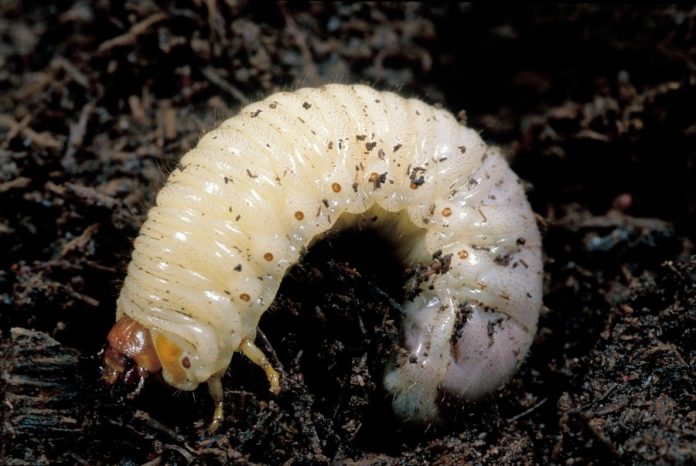If you’re digging in the garden or removing sod, you may encounter a creamy white, worm-like creature with a dark head and tail. If it keeps curling into a C-shape and has six legs, that creature is most likely a grub, or grubworm.
Grubs are the larvae of beetles. The most common grub in North Texas is the June beetle (Phyllophaga species) larva. Other names for June beetles include June bug, May beetle and May bug.
Grubs feed on the roots of plants just below the surface. They prefer the roots of turf grasses but also eat roots of other newly germinated plants. High numbers of grubs feeding in your soil can kill turf in a short time. Grub-damaged turf can be rolled up like a rug. Grubs can also leave seedlings or young garden transplants lying on the ground, having been cut at the base of the stem by the grubworms.
Grub sitings peak from April through September. Most adults emerge between the end of May and early July. They retreat deeper into the ground during winter for protection. Homeowners may not even realize they have grubs in their landscape until they wake up and find damage caused by hungry armadillos rooting into the soil to find their the grubworm dinner.
Anyone concerned about grub damage can spot check their property by digging square foot holes about six inches deep in several locations. If there are less than five grubs per square foot, they are unlikely to cause significant harm to plants or turf grasses. Low numbers may even benefit plants by improving soil aeration and permeability as they burrow. Some turf types can tolerate up 15-20 grubs per square foot if moisture and light requirements for them are met.
Integrated Pest Management (IPM) strategies are the best options to control grubs, allowing for the least environmental harm while protecting turf and plants. IPM methods are generally recognized as safe to use in food growing space and provide localized control. Grub infestations tend to be in small areas, allowing efficient application of IPM. Some people smash or drown grubs as they find them. Others gather grubs and place them in a feeder or a shallow pan for birds, toads or lizards. Some choose to carefully follow directions to apply a specific beneficial nematode, Heterorhabditis bacteriophora, to kill grubs. Providing a welcoming environment for scoliid wasps that lay eggs inside the grubs which to feed their larvae helps limit grub numbers, too.
Correctly timing IPM or application of other grub controls is critical. Early larval stages are most susceptible to chemical grub control. Gardeners choosing that route have better success by applying a chemical control about five weeks after the peak June bug emergence.
Happy Gardening!
Submitted by Janice Yoder-Smith



















